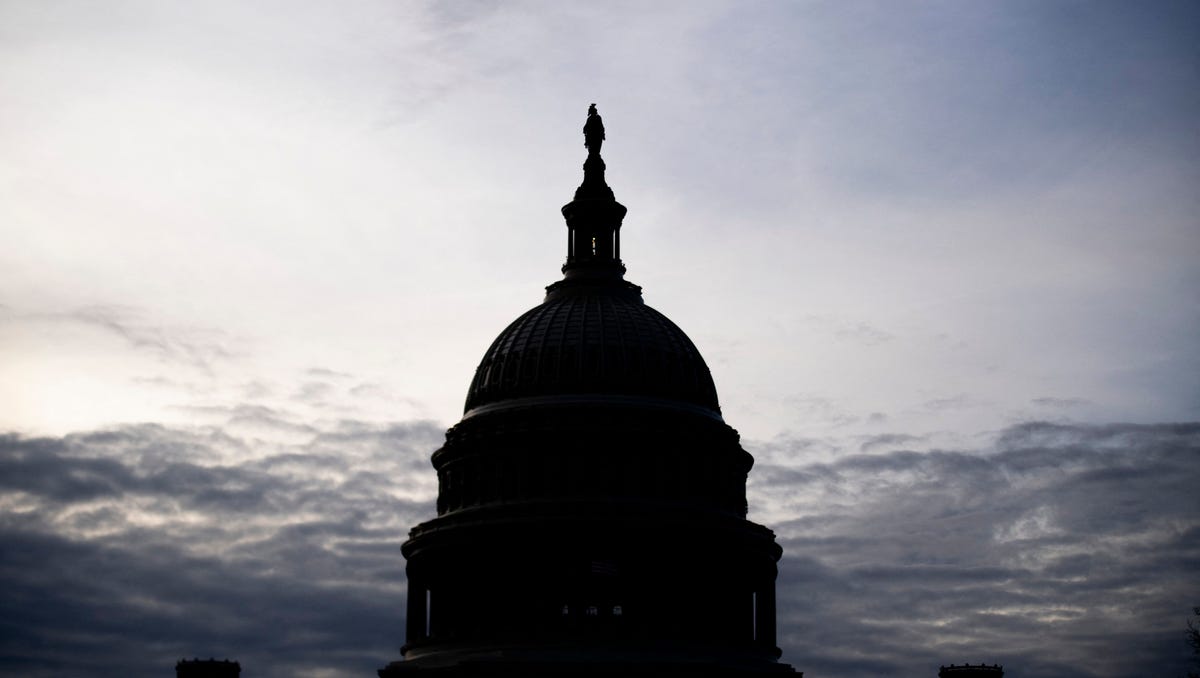If there’s a government shutdown, here’s what you need to know
From Social Security checks to national parks, here’s how a government shutdown would (or wouldn’t) disrupt the United States.
Just the FAQs, USA TODAY
The House on Tuesday approved newly minted Speaker Mike Johnson’s proposed funding extension, setting the stage for a Senate vote this week that would again, temporarily, sidestep the nation’s 22nd government shutdown in the last five decades.
Should the extension fail in the Senate, the results could be catastrophic.
The disruptions that come with shutdowns of the federal government have only become more familiar to Americans in recent years, and in September, legislators narrowly avoided a shutdown by temporarily extending government funding through the end of this week.
Johnson’s proposal offers a two-step extension of current funding levels and was accepted by House Democrats but drew the ire of hard right Republicans, reflecting the sharp divides that have recently stifled the party.
GOP splits as House passes spending plan lowering the odds of a disastrous government shutdown
The last time Congress failed to pass a government spending bill, in late 2018, around 800,000 Americans were furloughed or went without pay, President Joe Biden wrote on X in September. Processing times at the Internal Revenue Service slowed down. Military families had less access to critical family support programs. Some federal support for Indigenous tribes came grinding to a halt.
As the September deadline loomed, a solution appeared unworkable. But with 12 hours remaining on the clock, then-House Speaker Kevin McCarthy, R-Calif., suddenly declared he would propose a short-term, stopgap measure to maintain current government funding levels despite opposition from the hard right, which had insisted on cutbacks. The deal was welcomed by enough lawmakers in the House and Senate that a shutdown was averted and lawmakers had a brief window to work out a long-term plan.
While that plan has yet to transpire, Tuesday’s House vote means the Senate could kick the can down the road a bit more. In the meantime, here’s what a shutdown might look like for federal agencies and some of the ways it could affect you and your family:
Will child care or day care be affected by government shutdown?
Although K-12 and higher education policy is largely handled at the state and local level, the impact on families could be significant, particularly when it comes to federally supported childcare services.
One program that would be immediately endangered is Head Start, which serves low-income families nationwide. The White House said in September that 10,000 children across the country would immediately lose access, as the Department of Health and Human Services would be unable to award federal grants to childcare centers.
As in past shutdowns, that would force some preschool and school readiness centers to close, according to the Center for American Progress, a progressive think tank. Bobby Kogan, a senior director of federal budget policy at the center, wrote in September that a shutdown “would have devastating impacts on essential programs that millions rely on for their health and safety.”
The longer it lasts, he wrote, the worse off those programs would be.
How will schools be affected by a government shutdown?
The Education Department updated its contingency plan just as lawmakers reached their last deal. Under the plan, the department would be forced to furlough about 90% of its staff within the first week of a funding lapse. Should a shutdown persist beyond that, some staff could be rotated in and out but total staffing would remain at under 11% of all full-time employees, the plan states.
Federal student aid – in the form of Pell Grants and federal direct student loans – would keep flowing, but those programs would operate with a minimum number of staff amid furloughs.
The lack of bandwidth could pose barriers for students with immediate needs, the department warned, and the damage done would depend on how long a shutdown endures. School districts and colleges would likely feel the hurt at the one-week mark.
“A protracted delay in Department obligations and payments beyond one week would severely curtail the cash flow to school districts, college and universities, vocational rehabilitation agencies, and other entities that depend on the Department’s discretionary funds to support their services,” the department’s guidance said.
Many colleges, for instance, rely on federal money to fund programs for disadvantaged students who wouldn’t otherwise go to college or are having trouble staying in school. So do rehabilitation agencies that offer services for young people with disabilities. In a drawn-out shutdown scenario, continued funding for those programs could be threatened.
The latest on student loan forgiveness? One huge question looms for Biden’s panel
How will food programs fare in a government shutdown?
When a shutdown loomed as a possibility in September, Agriculture Secretary Tom Vilsack raised alarm about the “real consequences to real people” that it could bring, saying it would bring about “significant disruption of the lives of millions of Americans.”
According to the Committee for a Responsible Federal Budget, a nonpartisan, nonprofit operation, SNAP program funding is mandatory, but a shutdown could impede delivery of food stamp benefits because the U.S. Department of Agriculture has usually been given only a 30-day window to send out benefits under previous continuing resolutions.
Additionally, the committee said, stores can’t renew their Electronic Benefit Transfer (EBT) card licenses during a shutdown, so any establishments whose licenses expire during a shutdown wouldn’t be able to accept SNAP benefits in the meantime.
In more immediate danger would be approximately 7 million moms and children who rely on the Special Supplemental Nutrition Program for Women, Infants, and Children, or WIC. That program, according to USDA, helps low-income mothers with infants and children at nutritional risk by offering easier access to things like food and health care referrals. Those benefits would dissipate within days, though some states might be able to use extra funding to stave off the effects for a week or two.
During the last government shutdown four years ago, the government nearly ran out of SNAP funding that would’ve affected some 40 million Americans.
The White House warned that most Environmental Protection Agency inspections of drinking water and chemical facilities would also be put on hold.
How will a shutdown affect rural America?
As harvest season descends on farmers across the country, the impact of a beltway logjam would be felt in rural America too.
Similar to previous shutdowns, marketing loans for many farmers would enter into a state of limbo as Farm Service Agency offices in most U.S. counties shutter. More broadly, USDA-backed housing loans for rural families would cease as well.
Will Social Security benefits be affected by a government shutdown? What about Medicare?
About 8,500 of the Social Security administration’s nearly 62,000 employees would be furloughed in the event of a shutdown, according to its 2024 fiscal year contingency plan.
“We will continue activities critical to our direct service operations and those needed to ensure accurate and timely payment of benefits,” the plan states.
Under the plan, agency services that would continue without interruption include processing of benefit applications, appeal requests and hearings, post-entitlement actions such as address changes and the issuing of new and replacement Social Security cards. A few services – such as verification of benefits, or corrections and updates to earnings records – would be temporarily suspended.
According to the Bipartisan Policy Center, a nonprofit organization based in Washington, D.C., major programs and benefits like Social Security and Medicare are generally unaffected by shutdowns because Congress has approved these programs to spend without an expiration date – what is known as mandatory spending, which comprises about $7 of every $10 spent by the federal government.
Will post offices be closed during a government shutdown?
The U.S. Postal Service “does not cease operations during any Federal lapse in appropriations as it is funded through a permanent no-year appropriation,” according to its 2024 fiscal year shutdown plan.
That’s in contrast to the Office of the Inspector General, which receives an annual appropriation from the Postal Service Fund as opposed to the U.S. Treasury. In the event of a shutdown, the office would continue operations using previously appropriate funds until they were depleted.
Once depleted, only Office of the Inspector General employees involved in agency activities “to protect life or property” – including law enforcement investigations and prosecutions of entities and individuals engaged in fraud or other postal service crimes – would continue, along with any support services necessary to maintain them.
How will housing programs and emergencies be handled during government shutdown?
While many federal programs such as homeless assistance grants and housing for veterans and those with disabilities will continue through a shutdown, most Department of Housing and Urban Development staff will not be in the office as there will be an extremely limited number of employees to answer emergency questions during a shutdown, HUD has said.
In its contingency plan, HUD said that monthly assistance programs, including housing operating and housing choice subsidies and multifamily assistance contracts, will be in operation – as long as funding is available.
In terms of the Federal Housing Administration, HUD said “the processing or closing of FHA-insured loans may be delayed,” due to possible staff shortages.
What a shutdown means for travelers: Here’s what to know
How will government shutdown affect travel plans?
A government shutdown wouldn’t necessarily be detrimental to your travel plans. But air traffic controllers and TSA agents would have to work without pay. The White House has suggested this would lead to longer wait times and significant delays across the country right as the busy Thanksgiving travel period kicks off.
During the 2019 shutdown, many of those federally supported workers started calling in sick in droves about two weeks in – that was when the airport woes set in.
Cruise vacations won’t necessarily feel the effects of a shutdown. National parks, on the other hand, could be impacted right away. While the decision on whether to close them will be up to the Biden administration, some of the nation’s parks have closed entirely during past shutdowns. Those that stayed open – and unstaffed – were left in states of disarray.
Marc Ramirez is a national correspondent for USA TODAY. You can reach him by email at [email protected].
Zachary Schermele is a breaking news and education reporter for USA TODAY. You can reach him by email at [email protected]. Follow him on X at @ZachSchermele.
Terry Collins is a national correspondent for USA TODAY. You can reach him by email at [email protected].

Amanda Smith is a dedicated U.S. correspondent with a passion for uncovering the stories that shape the nation. With a background in political science, she provides in-depth analysis and insightful commentary on domestic affairs, ensuring readers are well-informed about the latest developments across the United States.






